ARM A53/A57/T760 investigated - Samsung Galaxy Note 4 Exynos Review
by Andrei Frumusanu & Ryan Smith on February 10, 2015 7:30 AM ESTGPU Performance
In the graphics department we're matching up Qualcomm's Adreno 420 versus the Mali T760MP6. The Adreno is running at 600MHz and is able to benefit from almost double the memory bandwidth at 25.6GB/s versus 13.2GB/s due to the Snapdragon's increased 128-bit memory interface. Let's look at how both compare in our overall benchmarks:

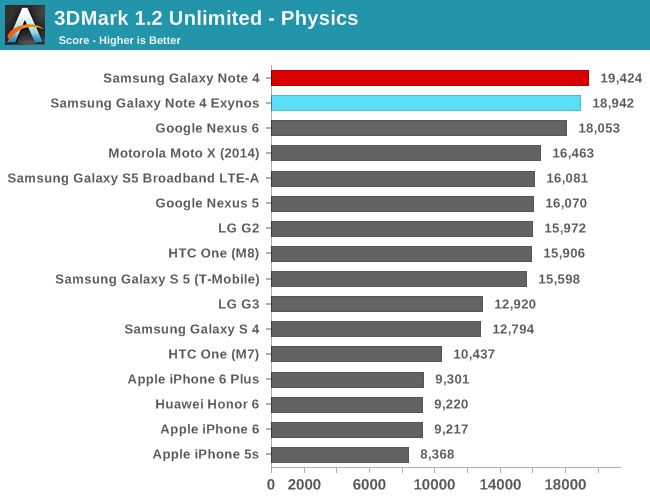
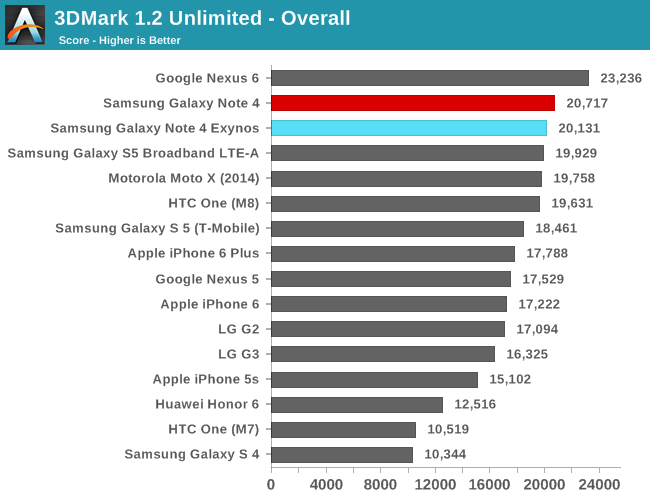
In 3DMark Unlimited the Exynos version comes just short of a few fps behind the Adreno 420. What is also surprising is that the Exynos 5433 performs much better in the physics score than I had anticipated; the same test on Huawei's SoCs limited the thread onto the little cores in the default settings giving mediocre performance results. However, it seems the A53 is performing much better and is able to match Qualcomm's offering now.
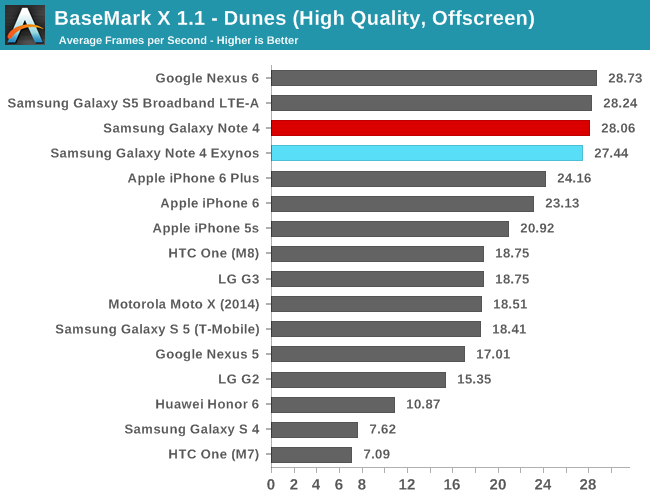
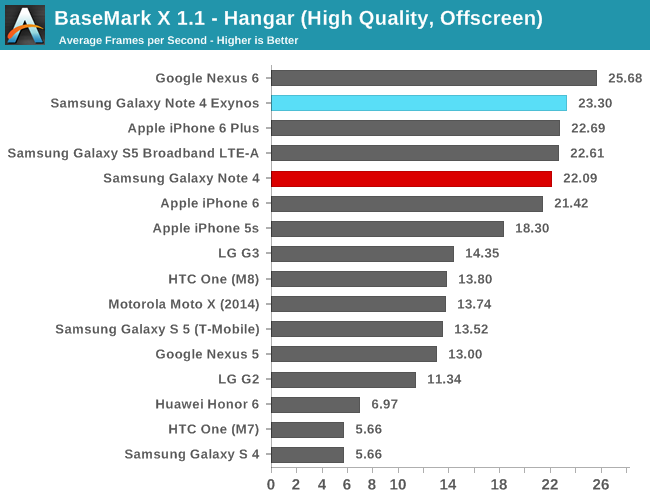
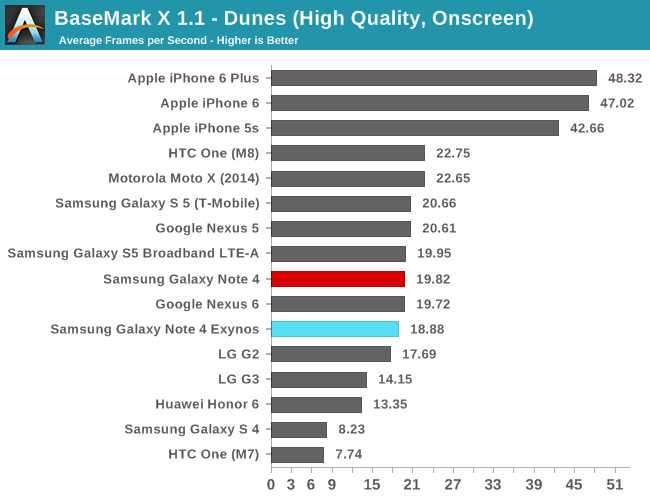

In BaseMark X 1.1, the Exynos is again neck-and-neck with the Snapdragon version. It loses by a slight margin in the Dunes benchmark while winning in the Hangar scenes by a similarly small margin. BaseMark X is again one of the benchmarks that can trigger the 700MHz state of the Mali GPU, offering higher performance at a much higher power draw depending on which scene is currently rendered on both tests.
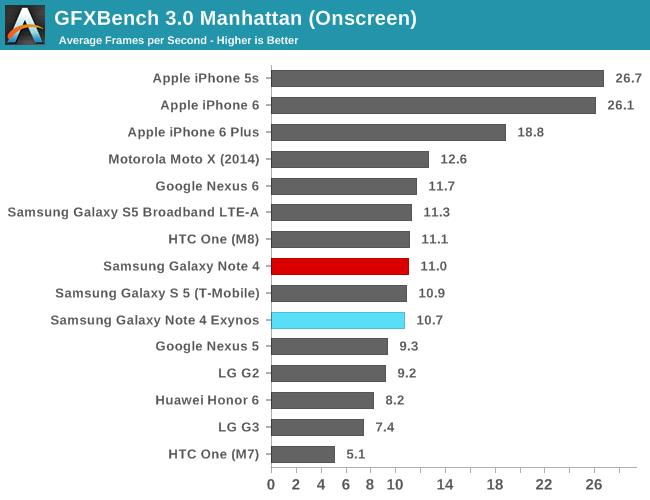
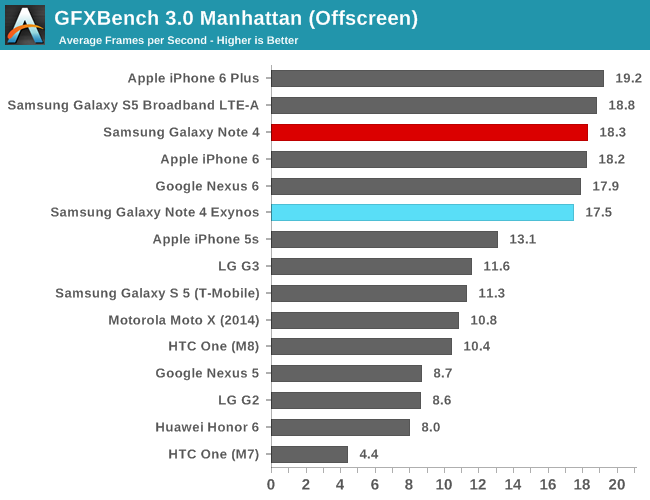
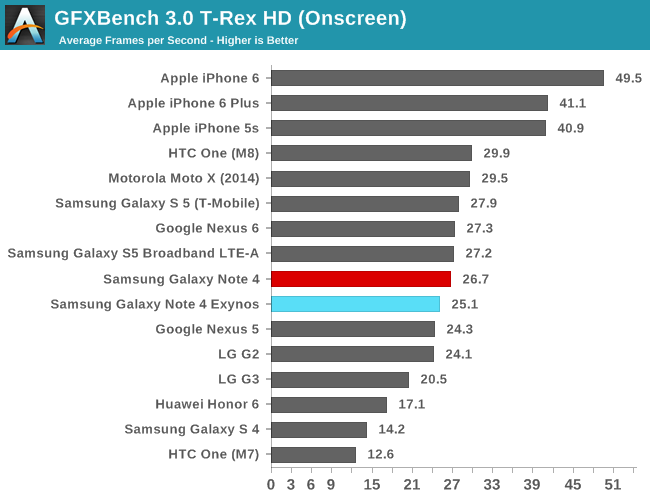
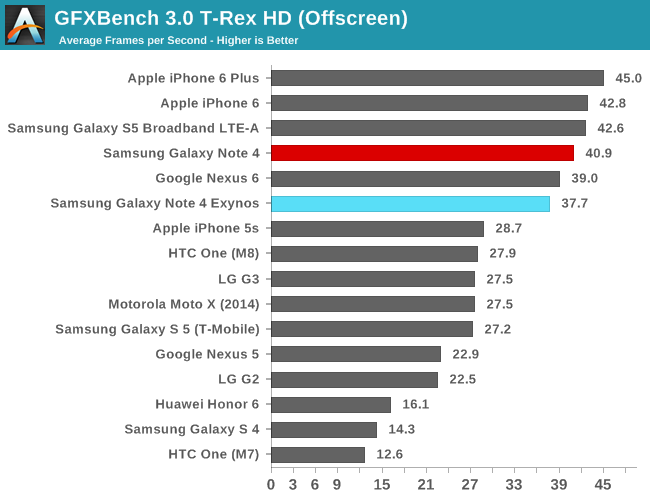
Again we continue to see the same pattern in GFXBench's scenario benchmarks, with the Exynos version lagging a few frames behind the Qualcomm GPU in both Manhattan and T-Rex, in both on-screen and off-screen results.
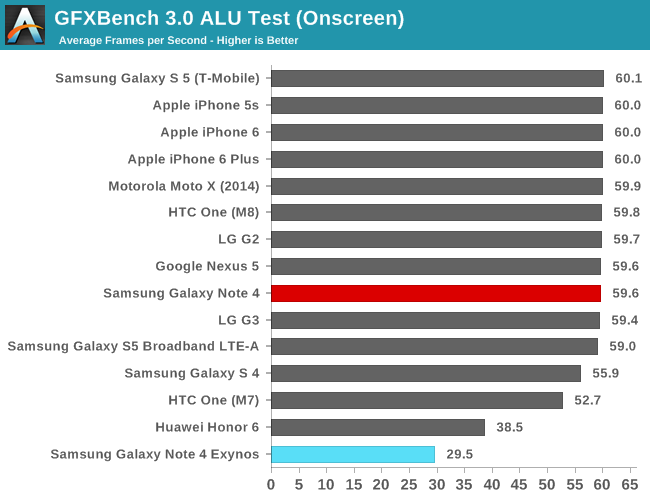

It's on the synthetic tests that we finally see some major deviation between the two architectures. ARM's Mali simply can't seem to keep up with the ALU throughput of Qualcomm's architecture. Both the Adreno 330 and 420 have a clear computational power advantage, exceeding even Imagination's PowerVR GPUs in the iPhones, leaving Mali strictly on the lower end of the performance spectrum.
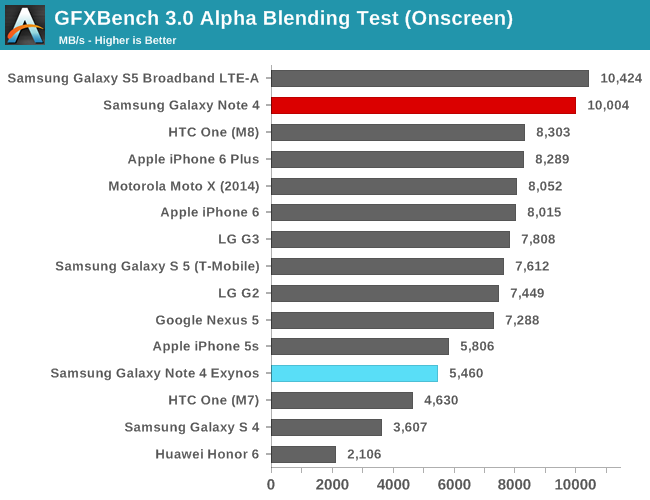
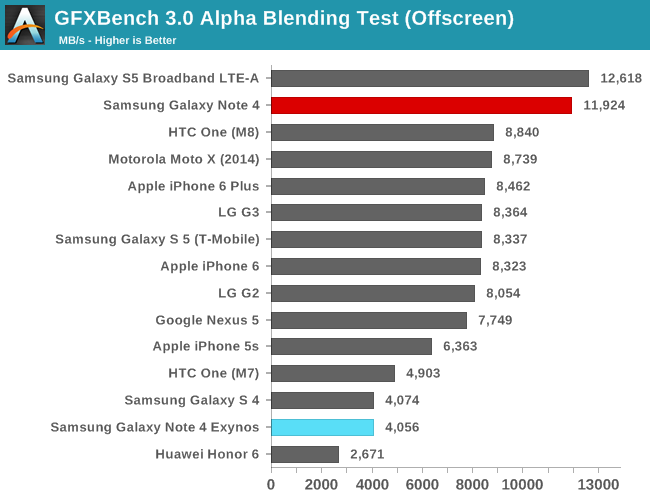
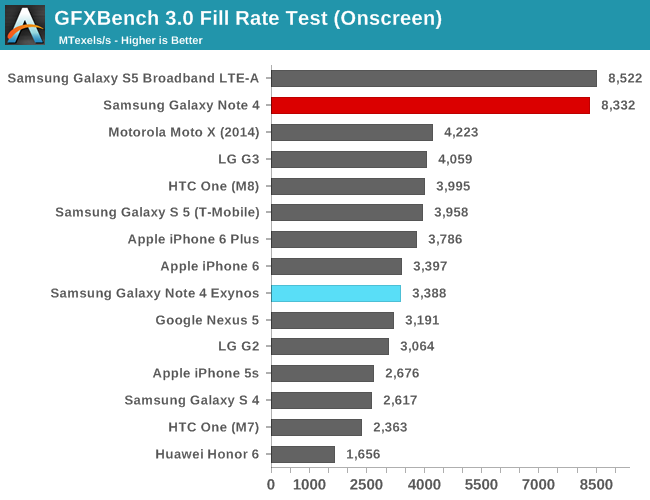
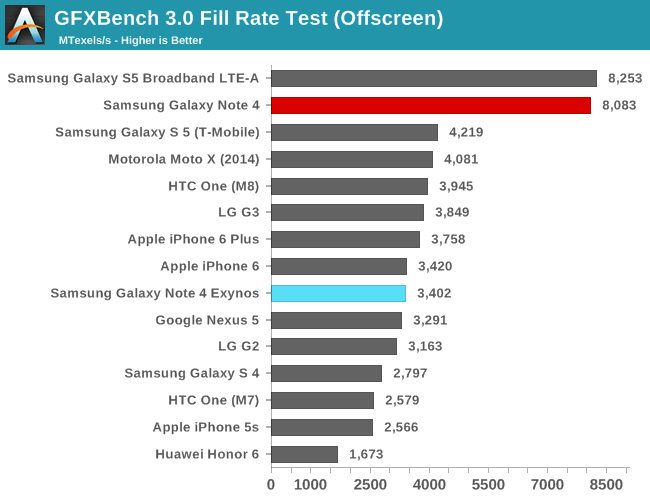
We see a similar situation in the Alpha Blending and Fillrate tests, as the Adreno offers 2-3x the throughput. Utilizing the extra memory bandwidth here seems to be key to the success of the Snapdragon 805's graphics performance.

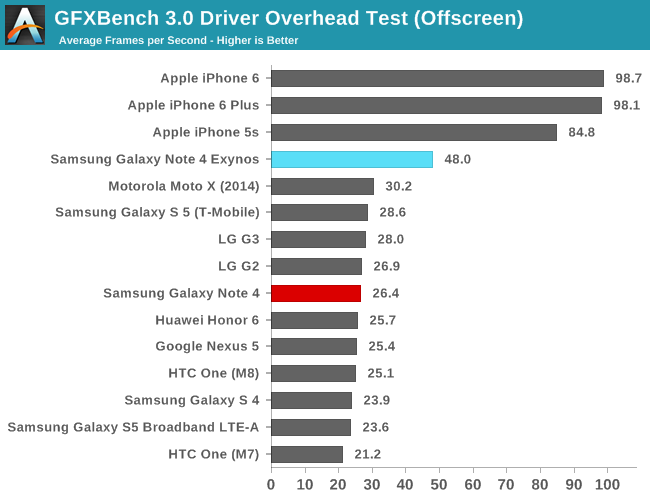
I've already mentioned the Driver Overhead score in the the more in-depth analysis of the T760. It's the first Android device to truly stand out from the rest of the crowd, finally making some progress into trying to catch up with Apple's excellent performance on iOS. Here's hoping more vendors concentrate on improving this metric in future driver updates.
I did some extensive power measurements on the Note 4 Exynos in this review, so naturally we're keen to see how this transforms into our battery benchmarks on the next page.










135 Comments
View All Comments
ddriver - Tuesday, February 10, 2015 - link
I'd like to see A57 performance without being so crippled by a ram bottleneck.blanarahul - Wednesday, February 11, 2015 - link
Loved this article. Only thing missing was gaming fps and power consumption comparison b/w LITTLE cluster only, big cluster only and big.LITTLE modes.ddriver - Thursday, February 12, 2015 - link
Also in true 64bit mode, cuz a lot of the perf improvements in v8 are not available in legacy 32bit mode.It is a shame really, samsung decided the uArch improvements would be enough to barely pass this chip as "incremental", they didn't bother to feed a higher throughput chip with a wider memory bus. As much as it pains me, apple did better in that aspect by not crippling their A7 chip, even if only because they needed it for a "wow factor" after so many generations of mediocre hardware, especially given the many exclusive initial shipment deals they secured to stay relevant.
thegeneral2010 - Wednesday, February 18, 2015 - link
i like wat u say and i really like to see note 4 running on 64bit this would give samsung processors a great push forward and trust of consumers.bigstrudel - Tuesday, February 10, 2015 - link
If it wasn't completely obvious already:Apple A Series stands alone years ahead of the rest of the pack.
Flunk - Tuesday, February 10, 2015 - link
But if they don't sell it to anyone else, it doesn't really matter does it?Apple doesn't compete with Samsung or Qualcomm when it comes to selling SoCs because they don't sell SoCs to other companies. A slight lead in CPU performance is not going to get people to buy an iPhone over and Android, if that's what they're set on buying.
xype - Tuesday, February 10, 2015 - link
It does matter insofar as to be a benchmark of what is possible (as long as they are ahead). And let’s not pretend Apple’s CPUs sucking wouldn’t invite the same kind of comments—just like every situation where 2 competing technologies are compared.Platform/fanboy trolling aside, that’s something Android users benefit from as well. Apple being "stubborn" about 2 core CPUs, for example, is a nice counterweight to the 8 cores and 8 mini-cores and 8 quasi-cores trend that some CPU vendors seem to have a hard-on for, and it gives a nice real-world example of how such an approach to mobile CPU design works out, no?
If Apple stays ahead in the mobile CPU game, the people using non-Apple phones will always have a target to point to and demand equality with. Otherwise they’d just have to live with whatever Qualcomm et al feed them.
bigstrudel - Tuesday, February 10, 2015 - link
My comment isn't fanboy jingo-ism. Its fact.There's not a single Android ARM core on the market that can even match the power of the Apple A7's Cyclone cores much less A8's 2nd gen design.
Were still waiting for anything custom to come out of the Android camp aside from the frankensteinish design of Nvidia's Denver core.
I really shouldn't need to explain why to people on Anandtech.
ergo98 - Tuesday, February 10, 2015 - link
The Tegra K1 64 bit is faster, core per core, versus the A8 (you do realize that the K1-64 has only 2 cores, right? I'm going to have to guess no, or you just are completely unable to read a chart). The A8x offers marginal per core performance advantages over the A8, and the primary benefit is the third core. The K1 64 is a A57 derivative, *exactly like the A8*.Your comments can only be construed as trolling. Can't match the A7? Give me a break.
tipoo - Tuesday, February 10, 2015 - link
Ergo, you're completely off. The Denver K1 is a VLIW code morphing architecture - it has nothing to do with the Cortex A57, nor does the Apple Cyclone, they're both custom architectures.The K1 offers better performance in benchmarks, but as a result of code morphing, it can be hit or miss in real world, causing jank.